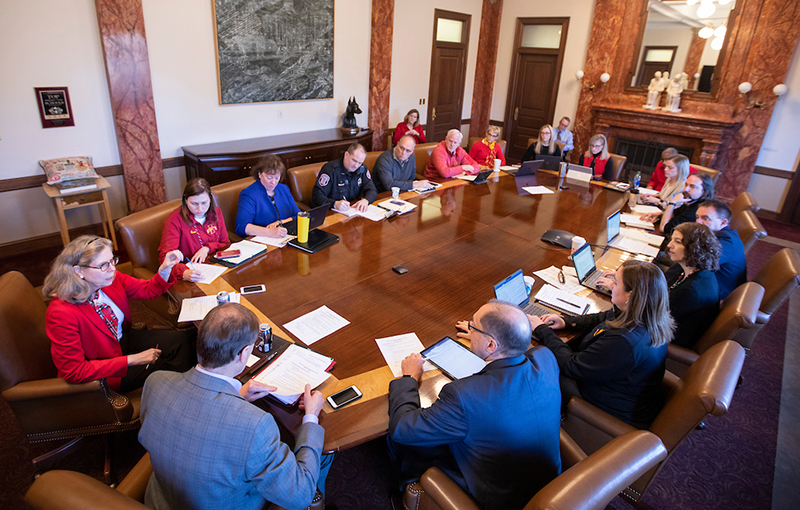
A meeting of campus leaders on March 13, 2020, in the closing days of in-person emergency meetings. Photo by Christopher Gannon.
Last week marked one year since the start of our pandemic year: virtual instruction, remote workplaces, shuttered labs, limited travel and a campus campaign to keep Cyclones apart and healthy. As we headed into spring break week 2020, the state Board of Regents mandated moving courses to online formats after the break and the World Health Organization announced a coronavirus global pandemic. Those came on the heels of several weeks of escalating travel restrictions.
Inside asked several campus leaders to reflect on that turbulent week:
- Erin Baldwin, associate vice president for student health and wellness, director of the Thielen Student Health Center and COVID-19 incident commander
- Kristi Darr, vice president for university human resources
- Pete Englin, associate vice president for campus life and director of the residence department
- Sara Marcketti, Morrill Professor in apparel, events and hospitality management and director of the Center for Excellence in Learning and Teaching
- Jonathan Wickert, senior vice president and provost
Below are excerpts from their responses to four questions.
What are your strongest memories from that week?
Englin: The uncertainty about whether it was realistic we would resume classes (after a proposed initial two weeks in virtual mode), and what does that mean for 9,000 students living with us -- and all their belongings? We kept items into June -- but we didn't know that yet in March. And hearing some early noise around the need to refund millions upon millions of room and board fees because people still would have housing and food expenses. The fair thing is to make that happen, the challenge is: What does that mean for our staff and their families? And finally, the overwhelming vulnerability of our students and staff about what COVID-19 might mean. How do we as a department, as well as a university, make this feel caring and supportive through a crisis of proportions we'd never seen?
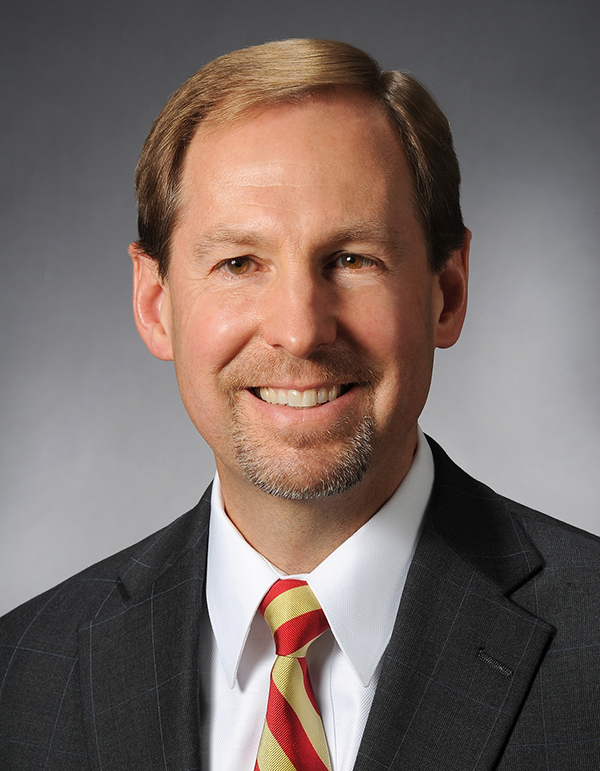
Jonathan Wickert
Wickert: It was a chain of events on Tuesday of that week. A weekly 10 a.m. meeting of my staff included a 'what-if' discussion about what we would do if we had to move classes online very quickly. Then there was a call after lunch involving the three universities and the board office about the possibility of going online. At 3:30, as the Faculty Senate meeting is starting in the Memorial Union Sun Room, I was in the back of the room on the phone with President Wintersteen, who informed me we were going online after spring break. Just as Jonathan Sturm was introducing me, the whole message I needed to share changed. So the very first announcement of the change, appropriately, was to Faculty Senate: We're going to move 7,000 classes online in 10 days, and we're going to have to figure it out.
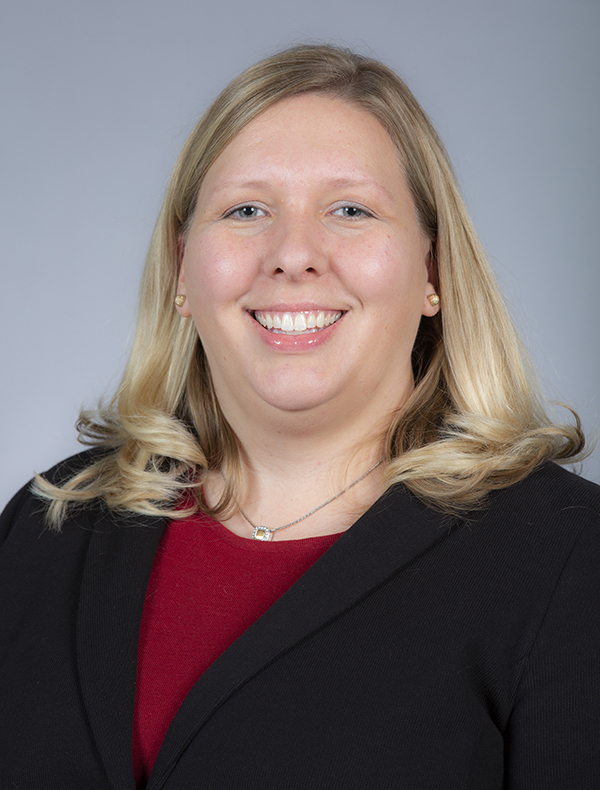
Erin Baldwin
Baldwin: I remember watching the virus spread in country after country and thinking 'This will be a pandemic.' My clearest memory is with all the support and coordination that was happening among study abroad, risk management, the health center and several colleges involved in returning our students from South Korea, China and Italy. There were many, many logistics to work out to support students and their families. Quarantining and testing were brand new ideas back then!
Darr: Feeling the pace pick up, the need to respond and be supportive and to have everyone's subject matter expertise be listened to. I recall a Friday afternoon meeting of campus leaders in the president's conference room (pictured above). We were in the same room, physically, and it was full. And how valuable it was to see expressions on faces, to develop relationships in those early days when we were all leaning in and learning.
What were the priorities guiding your decision-making as things evolved so quickly?
Wickert: From Day One, the two priorities I tried to share consistently were: Ensure the health and safety of students, faculty and staff; and maintain students' progress toward completing their degrees.
Baldwin: Staying connected to the most up-to-date information from the experts -- CDC, World Health Organization, Iowa Department of Public Health and local public health experts -- to make science-based decisions for Iowa State. And then to make sure we were communicating information and resources with campus. And, most importantly, making sure our planning supported our students, faculty and staff.
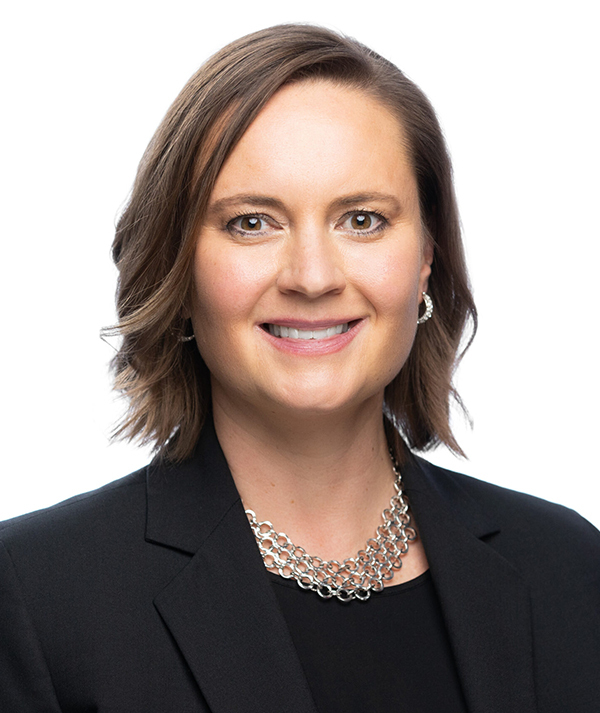
Sara Marcketti
Marcketti: First, to keep calm. The very word 'pandemic' is frightful. As CELT director, a faculty member teaching that semester, a mom, I knew I had to keep a level head even if internally I felt pretty stirred up. Number two, to communicate as clearly as we could through our website, teaching tips and programming information that was as simple as possible. We wanted to make sure we were contributing to the coordinated university response during a very chaotic time.
Englin: First, it was the students and our staff and their well-being. And then came the organizational implications: How to sustain and honor our Iowa State model -- the whole Cyclone experience -- that's been in existence since the university started. But I trusted in our collective resilience that we would find a way forward because that's what our history is. To know that ultimately, we will be OK, even though we don't know what tomorrow will bring.
What was the moment when you realized everything would change?
Baldwin: As early as February, as we were comparing COVID to other illnesses, I think I knew what was coming. I remember presenting to President's Council in February on COVID, and now we know that was just the base of what was coming.
Marcketti: I led an inclusive training workshop for the agronomy department late Friday afternoon (March 13) and was walking back to Morrill Hall. Campus was really quiet, and it hit me that workshop might be the last time I stood that close to people or shook their hands. It was really clear to me that this was it.
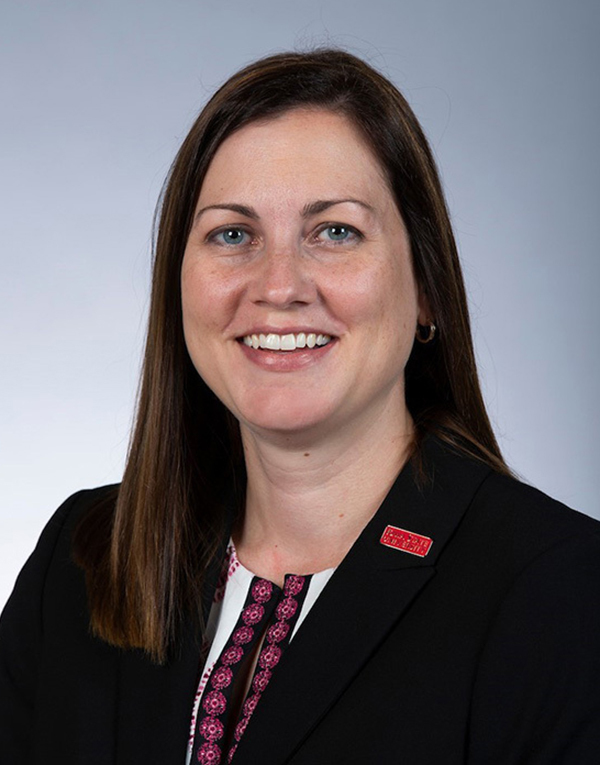
Kristi Darr
Darr: My family made the decision to go ahead with a spring break trip to visit grandparents in Ohio [Workday preempted spring trips the previous few years]. But that weekend (March 14-15), the weight of the worry for all our faculty and staff's safety was enormous. I was realizing I couldn't manage this from Ohio with a cellphone and a bad connection. So, on Sunday we headed back to Iowa. I rode in the passenger seat and had a little mobile command center with two phones and a laptop, talking on the phone, evaluating documents, getting updates from others. I felt so relieved when we got here.
Englin: Things began for the residence department when we were providing isolation and quarantine housing for students returning from study abroad, including Italy. We watched the enormity of what was happening [in Italy] in what felt like minutes. It felt like waiting for a tsunami to come but understanding there was no way to avoid it. I came to the realization this wasn't going to be a two-week dynamic; this was going to be with us for a while. I would never have guessed a year.
A year later, what's your assessment of that week and the university's initial response to really challenging circumstances?
Marcketti: We kept the reason we have a university -- our students -- at the heart of decisions. We talk about silos, but I saw a lot of people with varied areas of expertise bringing their knowledge, their care and support to try to help our students and help each other. There was a calmness, a reasoned response coming from the president's office and the provost's office, and at CELT we just tried to follow that.
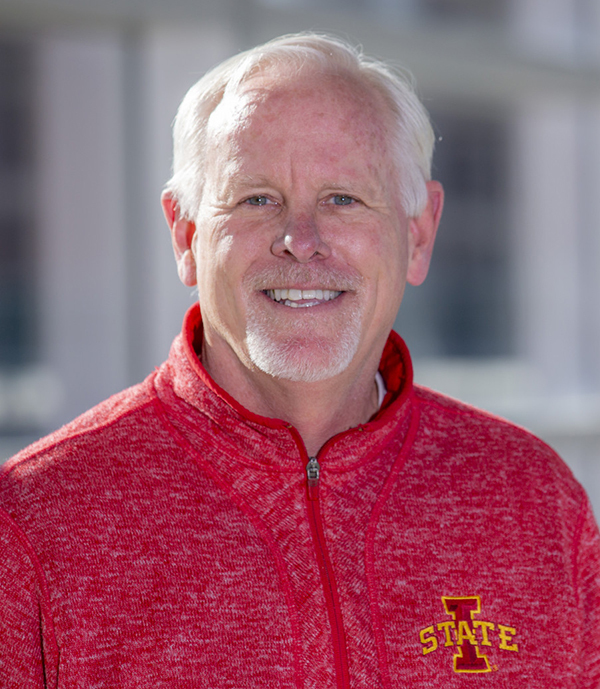
Pete Englin
Englin: Similar to when campus flooded a few times, I was reminded how Iowa State shines when faced with immense challenges. I can't point to another institution and say 'They figured this out better than we ever did.' I don't know one. Iowa State has done an incredible job of threading the needle. And not one decision has been easy because every decision had people who were cheerleaders for what we were doing and others who would engage in a deep critique and raise objections. There weren't any clear-cut decisions.
Wickert: My main reaction is one of pride in everyone at the university. I'm talking about our police force, residence staff, communications team, faculty, an 18-year-old freshman adapting to so many things. We were dealing with a new, frankly scary, thing, and our reaction was, we're going to roll up our sleeves, we're going to break it down and we're going to work the problem.
Darr: Just really great teamwork. There weren't a lot of lanes early on; it was just share information, hear information and adjust. You could just watch, first one unit kind of be in the fire, then the next unit was in the fire as we rolled to the next big decision -- study abroad students, employee safety, online instruction. Folks just leaned in, raised their hand and said 'Hey, did you think of this?'
Baldwin: Our really large campus came together to make some massively complex changes happen in a matter of days. Specifically, in my role of incident commander and as leader of the public health team, I'm so incredibly proud of how we stood up a public health infrastructure from the ground up, particularly because we don't have a health care system or medical or public health school to support our work. So many colleagues from across campus stepped up to make it happen.
